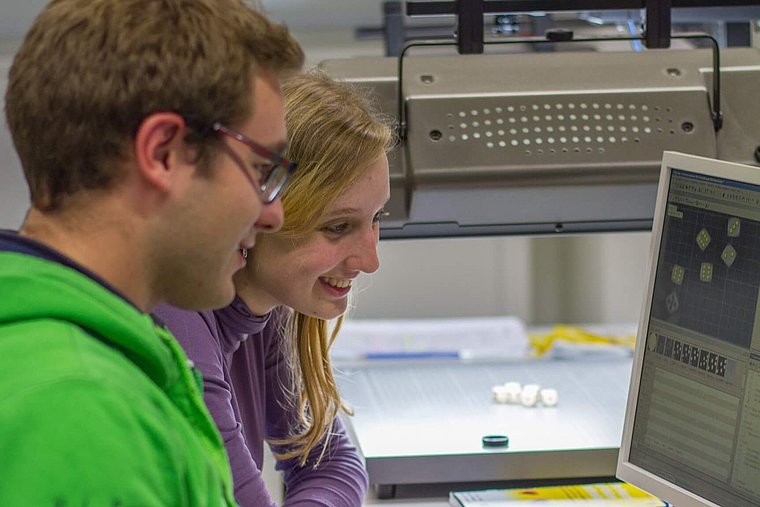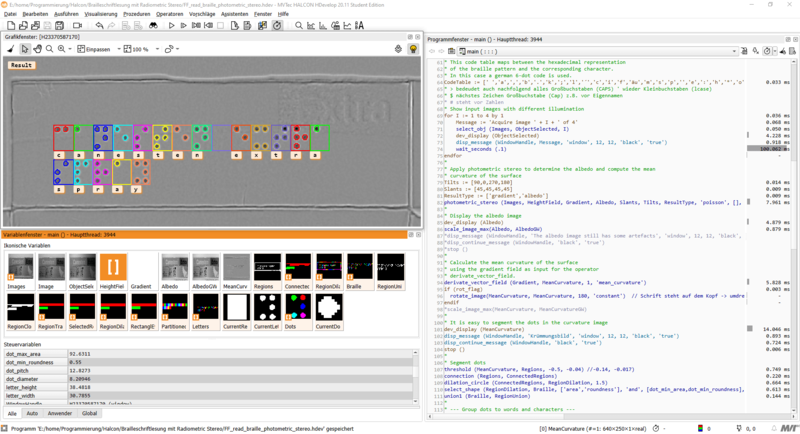
Darmstadt University of Applied Sciences
Education, Research & ScienceCAMPUS STORY
In the course "Optotechnology and Image Processing" (OBV) students get to work with MVTec HALCON in numerous lectures and laboratory exercises. In the following interview Mr. Michael Stelzl, lecturer, and Mr. Frank Friehl, laboratory engineer, of Darmstadt University of Applied Sciences will share their experience on working with HALCON in the academic environment.

Why did you decide to use HALCON in teaching or research?
The Integrated Development Environment HDevelop gives our students easy access to very powerful algorithms without having to have any specialized programming knowledge.
The scripting language enables the rapid creation of initially simple, but later increasingly complex "algorithm chains". These algorithms can be demonstrated practically in various lectures and laboratory assignments. Through the simple connection with cameras, students can also apply them themselves and observe them on the live image.
The well-thought-out documentation and the many example programs enable the students to deepen their knowledge independently.
The know-how on a widespread and established software library makes it much easier for our students to start their professional life. During the 18 weeks of the internship, they can apply their knowledge at companies and gain extensive practical experience in real projects. This also makes the students sought-after employees in a time of increasing shortage of skilled workers.
When did you start using HALCON at your university? How do you integrate HALCON into your lectures?
Darmstadt University of Applied Sciences received its first licenses for projects in 2004. Since the winter semester 2013/2014, HALCON has been firmly integrated as a standard tool in the course "Machine Vision Fundamentals " in the 2nd semester.
In the winter semester 2014/2015, the course "Image Processing with HALCON" was then taught for the first time.
In the winter semester 2017/2018, the MVTec on Campus program was implemented as a pilot project. From this point on HALCON was increasingly used in other courses.
After the pilot phase with students and some benchmarks with other tools, HALCON prevailed. The main reasons were the ease of use and the fast way from simple algorithms to complex solutions enabled by HDevelop. Furthermore, from our point of view, the standard image processing software offers a good combination of basics and state-of-the-art technologies. The software is professionally and continuously maintained and systematically enhanced.
HALCON is compatible with a wide range of operating systems and interfaces with hundreds of industrial cameras and frame grabbers, especially by supporting standards such as GenICam or GigE Vision.

What task is taught or solved with MVTec's vision product and how?
HALCON is used in many courses and associated lab assignments in our study program “Optotechnik und Bildverarbeitung" (Photonics and Machine Vision).
Bachelor courses:
In the course "Machine Vision Fundamentals" in the first year of the bachelor studies, our students gain first experiences with image acquisition (illumination methods, lenses, camera) and work out their first machine vision scripts (segmentation and classification of objects based on their shape features).
This is followed by the course "Image Processing with HALCON", where our students gain deeper knowledge as well as practical experience with some of the technologies available in HALCON. For example, we work on technologies such as deep learning, classification, morphology, blob analysis, and deflectometry.
In the third-year course "Applied Machine Vision", we teach methods and techniques that are important for the practical use of image processing, especially in an industrial environment. For example, triggered, flashed recording of fast-moving objects on a conveyor belt, image recording with a line scan camera, and working with robots and intelligent cameras.
HDevelop is used for the following tasks, in part with scripts pre-defined for the respective task: data matrix code reading, subpixel-precise measurement, classification of objects based on their shape features or via Deep Learning, quality inspection of an LC display.
In our experimental setup for image acquisition with a line scan camera, an HDevelop script handles both the control of the system and the image acquisition. Students can adjust parameters for linear axis control and triggering of the line scan camera, as well as the illumination profile of the line scan light via the script. The captured images can then be analyzed directly in HDevelop.

Master's Degree Programs:
In the first year of the master our students take the course "Advanced Applied Machine Vision" to gain knowledge about 3D scanning and volume determination using light section sensor, Photometric Stereo with Braille reading and the HDR image acquisition. The respective topics are followed by corresponding laboratory assignments in which the students can apply the software themselves.
What are the advantages of using MVTec on Campus? What feedback do you receive from the students or your research team about MVTec on Campus?
We regularly receive positive feedback from both students and industry, such as from IMSTec GmbH in Klein-Winternheim:
"IMSTec GmbH in Klein-Winternheim has been using HALCON in its projects ever since its establishment in 2005. The practical and profound knowledge, which the course of studies "Optotechnik und Bildverarbeitung" (Photonics and Machine Vision) of the University of Applied Sciences Darmstadt imparts, makes the students and graduates very interesting and valuable employees for us.
Hundreds of high-tech projects could be successfully realized by the synthesis of OBV-engineers and the software of MVTec in the last 15 years." - Robert Schäfer, Image Technology Department Manager
Thank you, Mr. Stelzl and Mr. Friehl, for the interview!
Would you also like to benefit from MVTec on Campus? Find out more about the areas of application of HALCON for teaching and research purposes.

